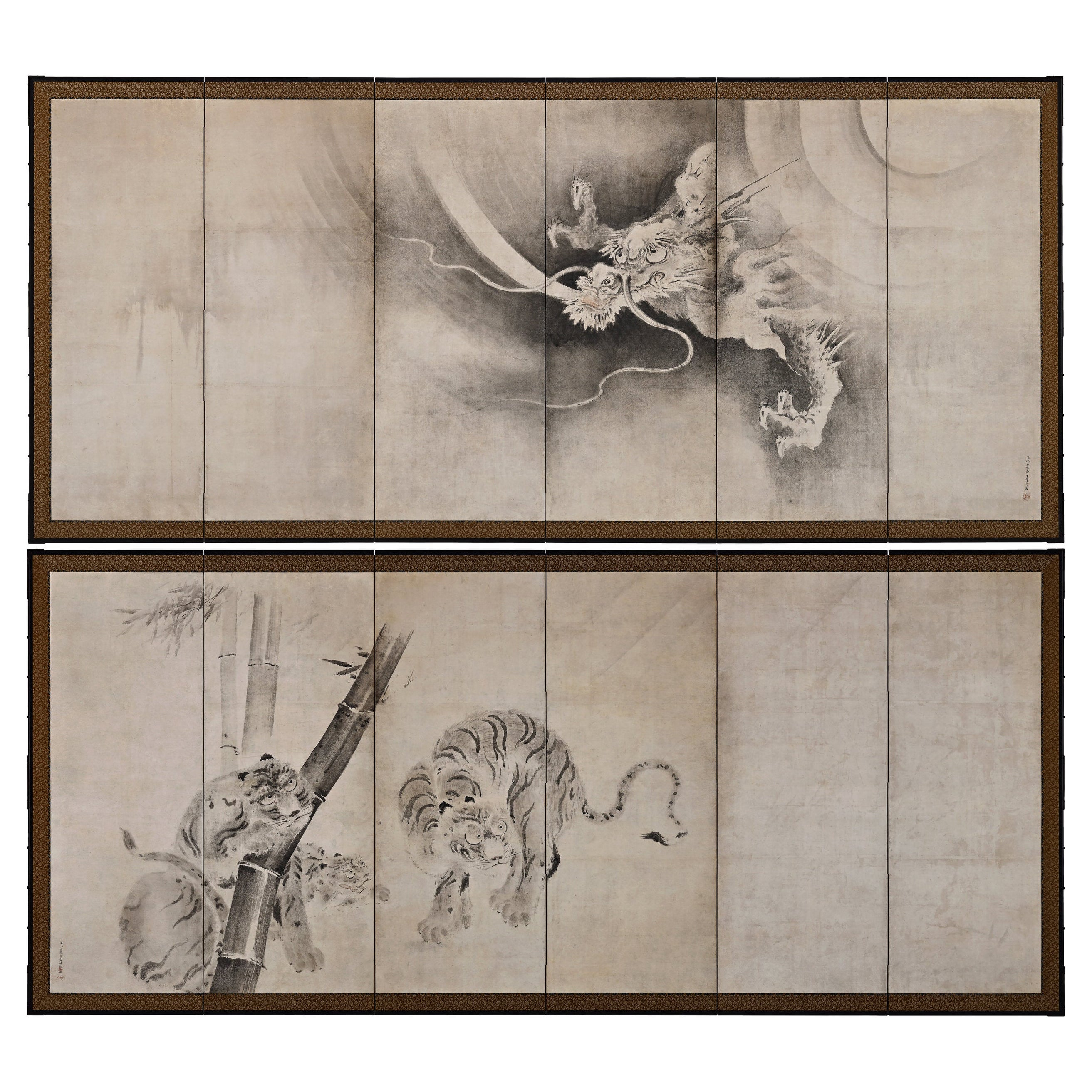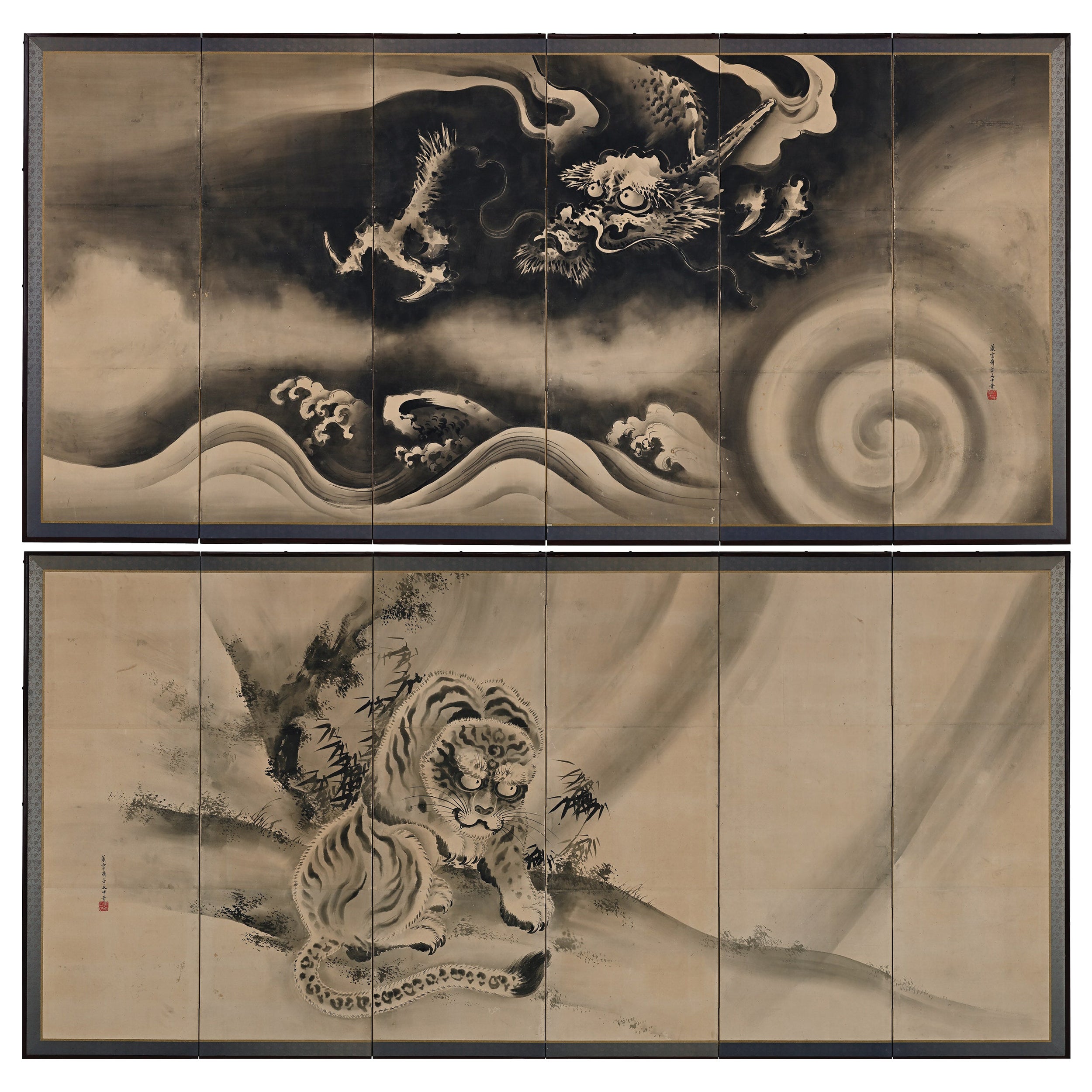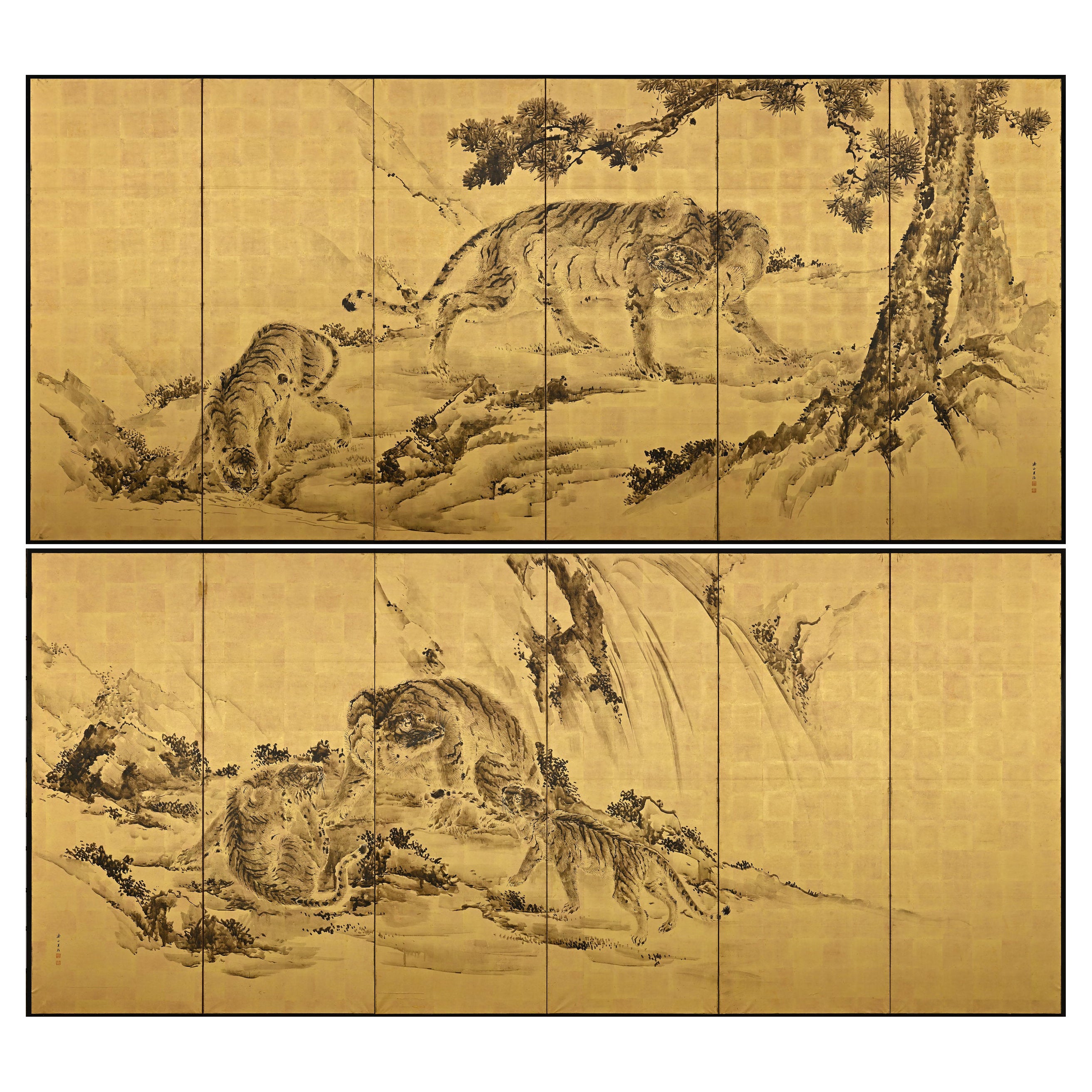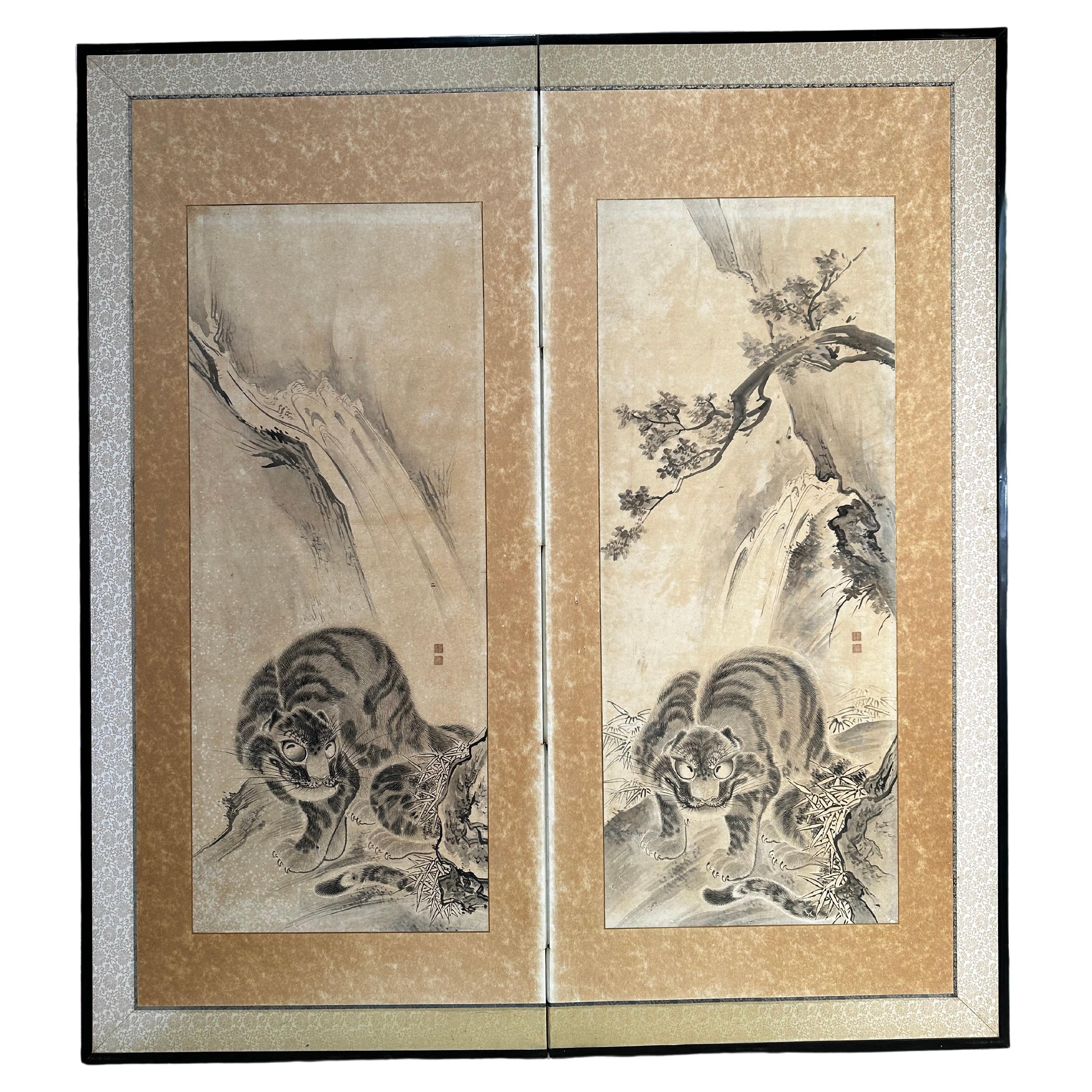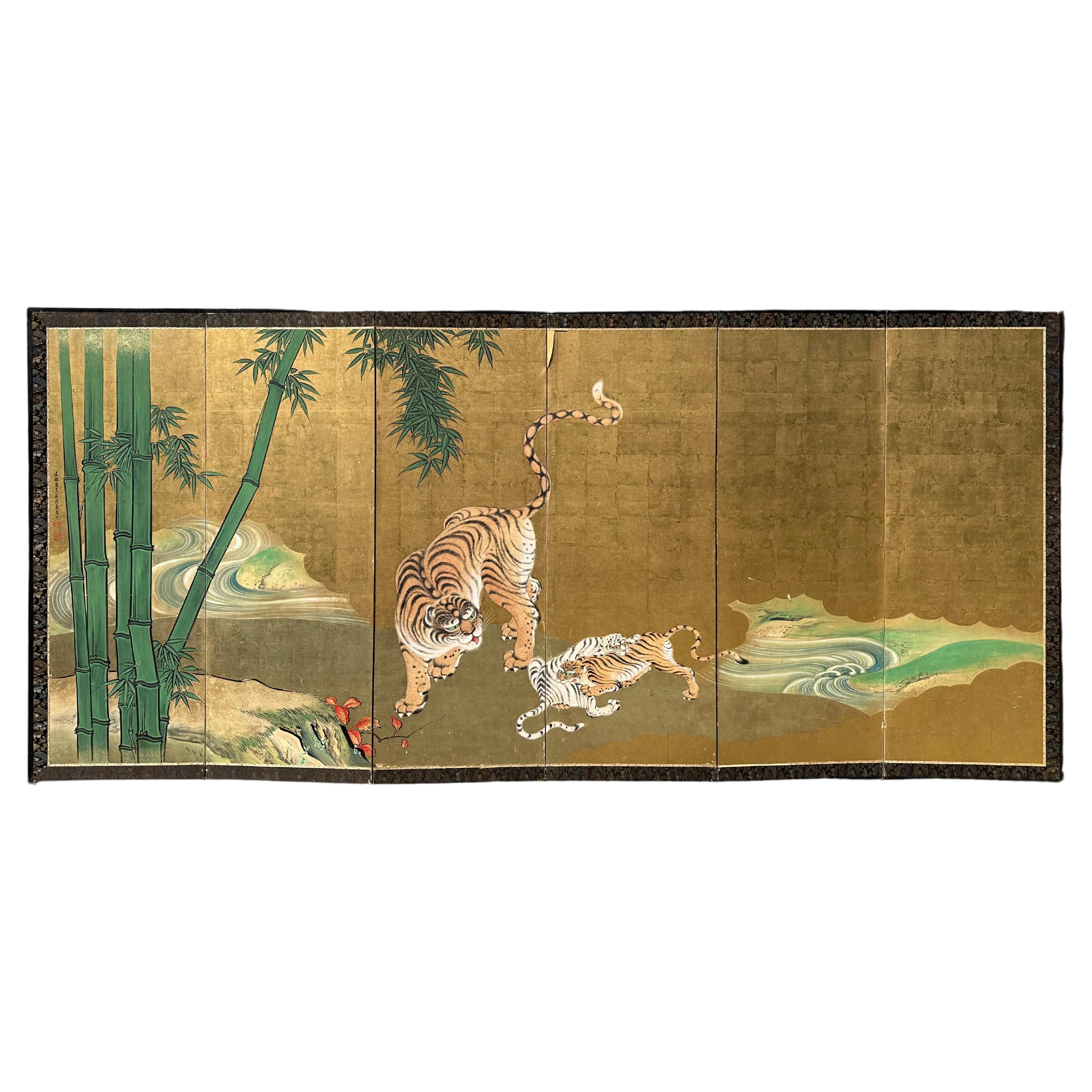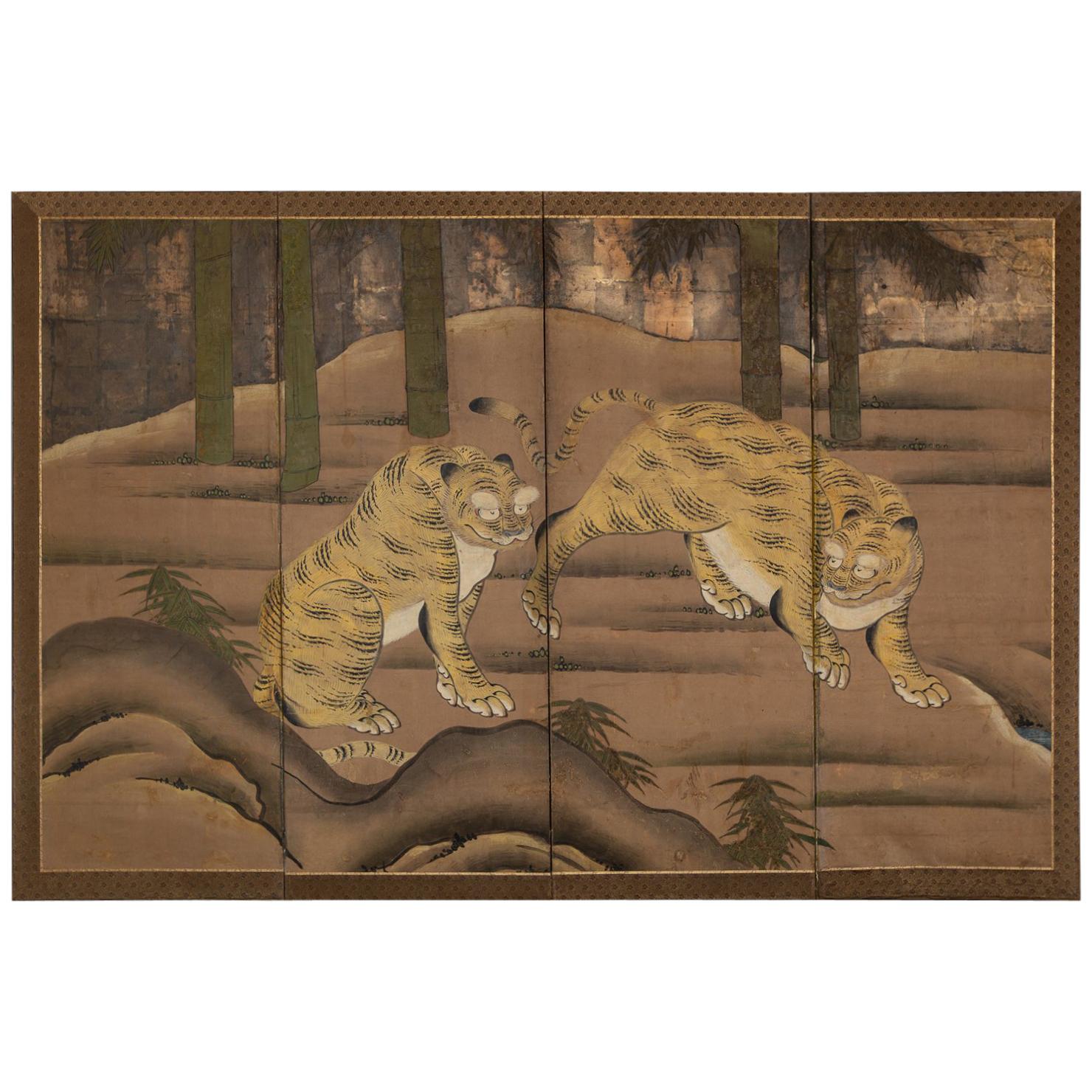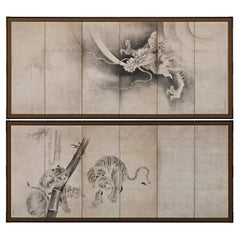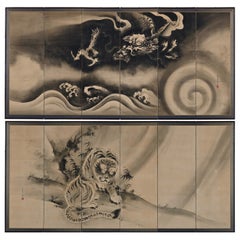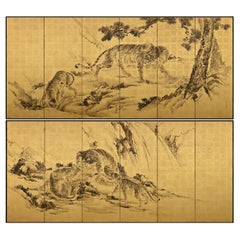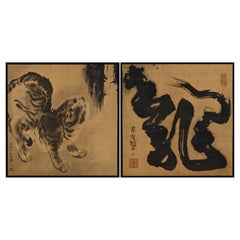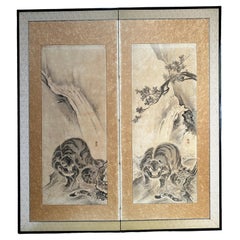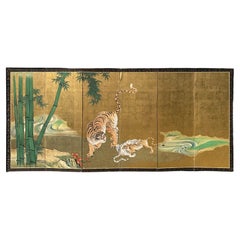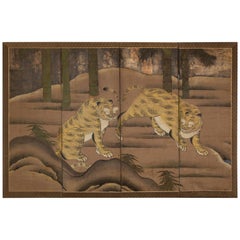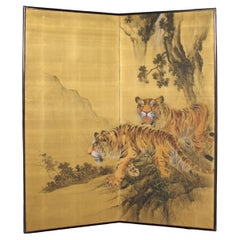Items Similar to Edo period Japanese Screen. Tiger and Pine by Kishi Ganku.
Want more images or videos?
Request additional images or videos from the seller
1 of 7
Edo period Japanese Screen. Tiger and Pine by Kishi Ganku.
$28,000
£21,261.06
€24,313.61
CA$39,120.06
A$43,510.05
CHF 22,719.59
MX$529,470.98
NOK 290,163.89
SEK 272,122.54
DKK 181,461.81
Shipping
Retrieving quote...The 1stDibs Promise:
Authenticity Guarantee,
Money-Back Guarantee,
24-Hour Cancellation
About the Item
Kishi Ganku (1749/1756-1838)
Tiger and Pine
A six-panel Japanese Screen. Ink on silver leaf.
The central focus of this Japanese screen is a large tiger, emerging from shadow, crouched beneath an ancient pine tree. The pine branches extend diagonally across the upper portion, creating a dynamic counterbalance to the grounded, muscular form of the tiger below. Sparse foliage and misty emptiness in the background emphasize the negative space, allowing the tiger and trees to dominate. The angled ink washes, slanting from the upper left toward the lower right, mimic the invisible force of wind sweeping through the landscape. They energize the composition and draw the viewer’s eye in a sweeping motion. The tiger has been associated with the earth and wind since ancient times, much as its counterpart, the dragon, has been associated with the heavens and rain. The entire background is covered with silver leaf, creating a luminous and atmospheric backdrop. Over time, the silver has oxidized, giving it a mottled, antique appearance of reflective silver, muted grays and copper browns. The oxidized silver leaf is a dynamic and reactive surface that changes dramatically in color and appearance depending on lighting conditions and angle of view.
Kishi Ganku (1749/1756-1838) is an artist whose birth year and birthplace are shrouded in mystery. He is said to have been born in either Kanazawa or Toyama, but he spent his childhood and youth in Kanazawa. After moving to Kyoto, he was discovered by Prince Arisugawa and served him, building connections with the Imperial Court and nobles. He produced paintings for the sliding doors of the Imperial Palace and Kanazawa Castle, and received many requests from feudal lords around the country. The Kishi school became a major force in Kyoto, alongside the Maruyama Shijo school. Ganku’s paintings of tigers were particularly popular. He was so skilled at painting tigers that he was nicknamed "Kishikoma no Tora. He was made honorary governor of Echizen (Echizen no kami, 越前守) toward the end of his life.
Initially, Ganku studied Kano style painting but early in his studies he shifted to explore the meticulous Nanpin style named for the Chinese painter Shen Nanpin (active early 18th century). Following his study of Nanpin, he explored Japanese naturalism under Maruyama Okyo, and Chinese-inspired naturalism under Matsumura Goshun of the Shijo school in Kyoto. Perhaps unsatisfied with any of these popular styles, he founded his own school, the Kishi school, characterized by a rough and vigorous brush style but still reflective of the many influences his training had provided.
- Dimensions:Height: 174 in (441.96 cm)Width: 146 in (370.84 cm)Depth: 0.75 in (1.91 cm)
- Style:Edo (Of the Period)
- Materials and Techniques:
- Place of Origin:
- Period:
- Date of Manufacture:Circa 1800
- Condition:Refinished. Wear consistent with age and use. The screen was most recently re-mounted approximately 20 years ago.
- Seller Location:Kyoto, JP
- Reference Number:1stDibs: LU2472345369062
About the Seller
5.0
Recognized Seller
These prestigious sellers are industry leaders and represent the highest echelon for item quality and design.
Established in 2001
1stDibs seller since 2016
70 sales on 1stDibs
Typical response time: 6 hours
- ShippingRetrieving quote...Shipping from: Kyoto, Japan
- Return Policy
Authenticity Guarantee
In the unlikely event there’s an issue with an item’s authenticity, contact us within 1 year for a full refund. DetailsMoney-Back Guarantee
If your item is not as described, is damaged in transit, or does not arrive, contact us within 7 days for a full refund. Details24-Hour Cancellation
You have a 24-hour grace period in which to reconsider your purchase, with no questions asked.Vetted Professional Sellers
Our world-class sellers must adhere to strict standards for service and quality, maintaining the integrity of our listings.Price-Match Guarantee
If you find that a seller listed the same item for a lower price elsewhere, we’ll match it.Trusted Global Delivery
Our best-in-class carrier network provides specialized shipping options worldwide, including custom delivery.More From This Seller
View All17th Century Japanese Screen Pair. Tiger & Dragon by Kaiho Yusetsu
Located in Kyoto, JP
Kaiho Yusetsu (1598-1677)
Tiger and Dragon
Early Edo Period, Circa 1650
A Pair of Six-fold Japanese Screens. Ink and slight color on paper.
Dimensions:
Each screen: H. 171 cm x W. 380 cm (67.5’’ x 149.5’’)
In this pair of early Edo period Japanese screens a group of tigers prowl in a bamboo grove whipped with fierce wind, while a dragon claws through clouds and mist. The dragon embodies elemental qualities - looming out of the mist, the coils of its body disappearing in the clouds. The dragon is calling for rain, symbolizing spring which is considered the fountain of life. On the other side, the tigers calls for the wind, symbolizing autumn which is considered the end of life. Tigers were familiar motifs within Japanese art from ancient times though the animals were imaginary to the people in the 17th century. While dragons and tigers are usually associated as sacred and ferocious, in this painting, both animals have rather amusing expressions. The tigers appear to glare at the dragon with cat-like eyes, and the look on the swirling dragon’s face appears almost affectionate - lending a playful flair to an otherwise magnificent theme.
The tiger and dragon are cosmological symbols of the balancing forces in the world. Screens such as this were originally meant to express the fluctuating nature of the world. For Japanese in the early Edo period, they likely suggested the powers of the cosmos. In Japan the tiger and dragon motif was originally absorbed into the circles of Zen monasteries before spreading into the secular world. The theme especially appealed to the military classes with the Kano school, the official painters to the Shogun and the samurai, being the leading contributors. The painter of this pair of screens, Kaiho Yusetsu (1598-1677), was closely patronized by the third Shogun Tokugawa Iemitsu. In his later years he worked with Kano school artists...
Category
Antique Mid-17th Century Japanese Edo Paintings and Screens
Materials
Silk, Wood, Paper
19th Century Japanese Screen Pair. Tiger & Dragon by Tani Bunchu.
Located in Kyoto, JP
Tani Bunchu (1823-1876)
Tiger and Dragon
A pair of six-panel Japanese screens. Ink on paper.
In this grand pair of Japanese Ryuko-zu screens the tiger crouches low to the ground, ...
Category
Antique Mid-19th Century Japanese Edo Paintings and Screens
Materials
Wood, Paper
Japanese Screen Pair, Tigers by Kishi Renzan, Late Edo Period
Located in Kyoto, JP
Kishi Renzan (1804-1859)
Tigers
Pair of six-panel Japanese screens.
Ink and gold-leaf on paper.
In this monochromatic pair of six-fold Japanese screens painted on gold-leaf, Kishi Renzan has created a breathtaking composition of a family of tigers. The screens are filled with a sense of drama which is conveyed by both the subject matter and the wet, expressive brushwork. The running mountain stream and the towering waterfall allude to refreshment during the summer months and we feel the tiger families familiarity and security within their environment. Renzan’s master, Kishi Ganku...
Category
Antique Mid-19th Century Asian Edo Paintings and Screens
Materials
Gold Leaf
19th Century Japanese Paintings. Zenga Tiger and Dragon by Inoue Kanshu.
Located in Kyoto, JP
Inoue Kanshu (1807-1880)
Zenga Tiger and Dragon
19th century
Pair of framed Japanese paintings. Ink on silk.
Dimensions (each): W. 114 cm x H. 115 cm (45” x 45”)
Presented here ...
Category
Antique Mid-19th Century Japanese Meiji Paintings and Screens
Materials
Silk
Japanese Screen Painting, Circa 1700 'Tales of Ise' by Tosa Mitsusuke
By Tosa Mitsusuke 1
Located in Kyoto, JP
A six-fold Japanese screen by Tosa Mitsusuke (1675-1710), Japan 17th-18th century, Edo period.
The signature reads Shoroku-i ge Tosa sa Konoe Shogen Mit...
Category
Antique Late 17th Century Japanese Edo Paintings and Screens
Materials
Gold Leaf
17th Century Japanese Screen. View of West Lake by Unkoku Toyo.
Located in Kyoto, JP
Unkoku Toyo (1612-1668)
View of West Lake
Pair of eight-panel Japanese Screens. Ink and gold wash on paper.
Dimensions: Each screen: H. 110 cm x W. 372 cm (43” x 147”)
This pair ...
Category
Antique Mid-17th Century Japanese Edo Paintings and Screens
Materials
Paper
You May Also Like
18th Century Nagasaki School Tiger Screen
Located in Fukuoka, JP
18th Century Nagasaki School Tiger Screen
Period: Edo
Size: 165 x 172 cm (65 x 67.7 inches)
SKU: PTA69
This exceptional 18th-century screen from the Edo...
Category
Antique Early 18th Century Japanese Edo Paintings and Screens
Materials
Wood, Paper
Edo Tiger Screens by Tosa Mitsusada
By Tosa School
Located in Fukuoka, JP
Edo Tiger Screens by Tosa Mitsusada
Period: Edo
Size: 358x175.5 cm
SKU: PTA119
Enter the captivating world of Japanese artistry with our pair of painted...
Category
Antique 18th Century Japanese Edo Paintings and Screens
Materials
Gold Leaf
Japanese Four Panel Screen: Two Tigers
Located in Hudson, NY
Two tigers exchanging amorous glances. Kano School painting.
Category
Antique 18th Century Japanese Paintings and Screens
Materials
Paper
B13 Japanese Antiques 2panels, silk, folding Screen with Tiger
Located in Niiza, JP
Material: Silk on wooden frame
One piece: W685×H1525mm×D20mm,
Unfolded size: W1370mm
Folded size: W685×H1525×D40mm, 5kg
Packaging (sandwiched with 5mm plywood): 10cm x 77cm x 160cm, ...
Category
20th Century Japanese Paintings and Screens
Materials
Silk
Late 19th century (Meiji period) painting depicting tiger
Located in Fukuoka, JP
Antique Tiger Painting on Paper – Meiji Period
A striking depiction of a tiger, painted on paper and signed by the artist. This work was originally part of a Japanese byobu folding ...
Category
Antique Late 19th Century Japanese Meiji Paintings and Screens
Materials
Gold Leaf
Large Japanese Scroll of a Tiger
Located in Hudson, NY
Wonderfully large and bold tiger painted in ink and mineral pigments on silk mounted with silk brocade border. Seal reads: Miyaguchi (alternative reading: ...
Category
Antique Early 1800s Japanese Edo Paintings and Screens
Materials
Silk
More Ways To Browse
Antique Explorer
Japanese Silver Leaf
Palace Door
Asian Tiger
Japanese Brushes
Asian Tiger Art
Painting Antique Pine Furniture
Antique Governor
Hand Painted Tiger
Tiger China
Used Screen Doors
Tiger Eye Furniture
Japanese Tiger
Japanese Sliding Doors
Castle Doors
Japanese Screen Kyoto
Japanese Door Panels
Antique Castle Doors
